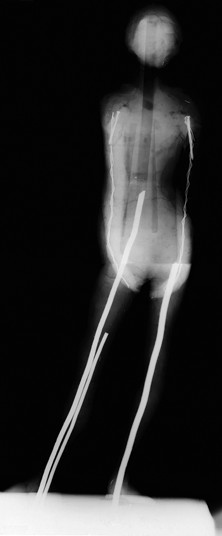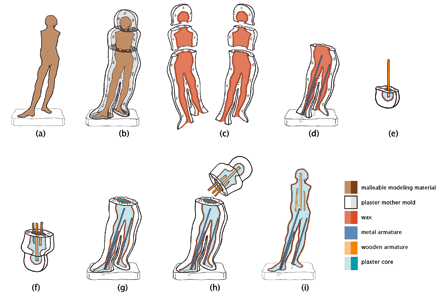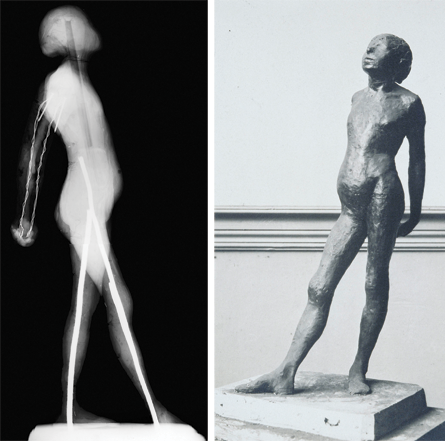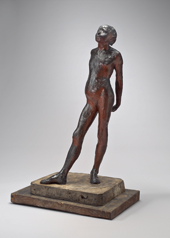
Fig. 1: Degas, Study in the Nude of Little Dancer Aged Fourteen, radiograph, front view
Technical Notes
Radiography (fig. 1) reveals that the figure is made from a homogeneous modeling material, identified using GC as beeswax,[1] over a plaster core, and supported on plaster and wooden bases. The arms, also beeswax, were modeled separately over twisted wire, identified using XRF as galvanized iron, and attached to the shoulders.[2] Like Little Dancer Aged Fourteen, Study in the Nude of Little Dancer Aged Fourteen is distinguished in scale and facture from all other sculpture by Degas in the remnant corpus. Furthermore, the complexity of manufacture evident in this work argues that Degas was assisted by a mold-maker as he fabricated this statuette.
Degas began his sculpture by modeling in clay or wax. From this original version, now lost, a mold in plaster was probably taken.[3] If a primary plaster sculpture was cast and a gelatin mold created from it in order to reproduce multiple versions of the same sculpture, no evidence exists today. However, the fact that lifetime plasters assembled from piece molds exist proves that Degas did use mold-makers.[4] Beyond the obvious desire to capture his work in a more durable medium, Degas’s reasons for molding this work are speculative.
It is tempting to suggest that Degas created this sculpture with a particular purpose in mind.[5] One possibility is that it was made for Louisine Havemeyer, who tried unsuccessfully to purchase Little Dancer Aged Fourteen. In 1903 Mary Cassatt wrote to Paul Durand-Ruel: “I have just received a letter from Mrs. Havemeyer about the statue [Little Dancer]. She will have nothing but the original, and she tells me that Degas, on the pretext that the wax has blackened, wants to do it all over in bronze or plaster with wax on the surface.”[6] However, bismuth identified in the wax matrix, described later in the Technical Notes, links this sculpture chronologically with The Schoolgirl, dating it to the late 1870s, as Lindsay proposes.

Fig. 2: Schematic diagram depicting the fabrication of Study in the Nude of Little Dancer Aged Fourteen. Illustration by Julia Sybalsky and Abigail Mack, 2007. a. Clay or wax model (no longer extant) of Study in the Nude of Little Dancer Aged Fourteen without arms; b. Plaster piece molds in three paired sections construc--ted over model; c. Piece molds removed from model and wax applied within cavities of the molded sections; d. Plaster piece molds of the legs, with wax and metal armatures applied to interior and mounted onto a base; e. Inverted plaster piece molds of head with wax applied to interior, poured plaster core, and wooden armature; f. Inverted plaster piece molds of upper torso atop molds of head from “e,” with poured plaster core and two additional wooden armatures; g. Paired piece molds of the legs with poured plaster core; h. While plaster core inside molds of the legs still wet, upper sections attached; i. Once plaster core set, piece molds removed to reveal Study in the Nude of Little Dancer Aged Fourteen without arms
Ultimately, for reasons that remain unknown, Degas partially cast this sculpture. To facilitate taking a mold, the sculpture was divided into three sections prior to molding in plaster (figs. 2a, 2b).[7] Placement of the armatures as three campaigns within the extant sculpture, revealed by radiography, supports this premise. Once the plaster mold sections were completed, they were opened longitudinally, forming six separate pieces (fig. 2c).[8] Raised seam lines, consistent with these longitudinal sections, run continuously from the head of the extant sculpture to the foot on each side, but exclude the arms.[9] Curiously, the arms of this sculpture were not molded. It is possible that they formed part of the original mold and that Degas, dissatisfied, modified the arms later in the process. Indeed, the absence of arms made the figure more self-contained and less cumbersome to mold.
Beeswax was then applied inside the recessed sections of the mold, either by painting molten wax or by pressing sheet wax (see fig. 2c). Successive applications of wax, evident from the many striations in the radiograph (see fig. 1), were applied until a desired thickness was achieved. Analysis using GC and SEM-EDS identified the wax medium as beeswax, pigmented with red iron oxide, brown earth, vermilion, lead white, bismuth white, and charcoal black extended using starch, quartz, calcium carbonate, and gypsum.[10] The surface of the wax still appears red today due to its iron oxide and vermilion pigments, although scattered areas have discolored.[11] The presence of bismuth white, found in only one other sculpture analyzed, implies that Degas used a wax different from that found on other works, perhaps one provided by a mold-maker.[12]
Once the wax had been applied within the mold pieces, paired sections were assembled and bound. Beginning at the base and working up, Degas and an assistant placed pipes, used as metal armatures of the legs, into holes previously cut into a working base (fig. 2d). The right leg has two pipes, the shorter one ending just above the knee and the longer one extending to the lower back; the left leg contains one that extends only to the buttocks. Prior to inserting, the pipes were wrapped with a thin wire that enhanced adhesion of the metal support to the plaster core later poured within the hollow of the mold.
As noted, plaster, identified using XRd as plaster of Paris (calcium sulfate dihydrate or gypsum) with carbon black, iron oxide, and calcium carbonate, was poured in three stages.[13] Given the choreography required to insert the wooden armatures into a wet plaster core, it seems likely that the first section to receive its core would have been the head. Mold sections, supported on the exterior, possibly with a mother mold, were turned upside down in order to pour plaster within the hollow. A wooden plank (with a jagged edge) was inserted into the core, providing sup-port to the neck and ultimately bridging the seam between neck and body (fig. 2e).
Once the plaster inside the head had dried, the molded sections of the torso were inverted, placed onto those of the head, and bound, encasing the long plank protruding from the dry core. Again plaster was poured into the hollow (fig. 2f), and two wooden slats were inserted into the wet core of the torso flanking the plank already positioned in the head. During the process, wet plaster seeped up into the neck, binding the core of the head, neck, and torso together. A distinct line between the plaster poured while the head was upside down and the plaster that seeped into the neck is evident in the radiograph (see fig. 1).[14] Lastly the molded sections for the legs, already placed around the armatures and bound, were filled with plaster (fig. 2g). At the same time, the upper two sections, now filled with dry plaster holding wooden armatures, were turned upright and placed on top (fig. 2h). A tiny vertical seam indicative of a plaster-to-plaster join is visible in the radiograph in the area along the plaster core, just above the navel.
After the plaster had set and the molds were disassembled, an armless sculpture internally supported by a plaster core and having a fairly smooth surface was revealed (fig. 2i). (Flashing and seam lines on the exterior could have been removed at this stage.) Surface details were enhanced after molding, as seen in the toolmarks apparent around the ears and mouth. What remained to be done was to fabricate the arms.

Figs. 3–4
left: Degas, Study in the Nude of Little Dancer Aged Fourteen, radiograph, profile view showing the fabrication of the arms
right: Study in the Nude of Little Dancer Aged Fourteen, photograph by Gauthier for the 1917 – 1918 Durand-Ruel inventory, Musée d’Orsay, Paris. Photo © RMN-Grand Palais / Art Resource, NY. Photographer: Franck RauxResource, NY (Hervé Lewandowski)
As observed in the radiograph, the core extends throughout the figure but excludes the arms (fig. 3). Modeled freehand over a twisted iron wire rather than cast, the arms were also formed from red beeswax. Analysis using GC and SEM-EDS revealed that the beeswax of the arms is consistent with that of the body, containing iron oxide, brown earth, vermilion, lead white, charcoal black, bismuth white, and extended with starch, quartz, calcium carbonate, and gypsum.[15]
To attach the arms to the figure, superficial wax at the truncation was scraped, exposing the plaster core of each upper arm. Wet plaster was then applied to the core, and a nail was embedded so that only the tip was exposed. The arms, from the bicep down, were next attached simply by pushing the arms onto the nail tip and filling the join just below the shoulder with wax. It is curious to note that the twisted wire within the arms was not entwined with the nail, though entwining would have provided a more secure connection to the body.[16]
Lastly, and again a unique feature to this sculpture, was a plaster base that was created specifically for the sculpture after it was completed.[17] The same plaster base as well as the wooden base on which it rests were recorded in the inventory photograph (fig. 4). Analysis using XRD of a sample from the base identified it as plaster of Paris containing traces of iron, zinc, and strontium as impurities.[18]
Nailed and stacked wooden boards, recorded in edges of the cast base, provided exterior walls into which plaster for the base could be poured. Impressions of boards nailed together to form the larger base are also cast into the sides of the plaster base. To create the base, plaster was poured into an open rectangular form. Once enough plaster to accommodate the armatures protruding from the feet had been poured into the form, the sculpture was placed on top. While the plaster was still wet, the right foot was adjusted, in the process leaving its footprint in the plaster.[19] Wet plaster was spread around the feet of the figure using broad-toothed tools as evident on the surface.
Though Degas’s purpose in making this figure cannot be determined from technical evidence, what can be emphasized is that he chose a labor-intensive means to achieve an end for this particular work and that he used a cast of a now-lost figure and completed the piece with a base. In that regard, Study in the Nude is a sculpture in its own right.
Provenance
The artist, Paris; his five heirs; (Adrien Aurélien Hébrard, Paris); his widow, Mme Adrien Aurélien Hébrard, and/or his daughter, Nelly Hébrard, Paris; consigned 1955, with most of the other lifetime works, to (M. Knoedler and Company, Inc., New York); sold May 25, 1956, to Paul Mellon, Upperville, Virginia.
Exhibited
Edgar Degas, 1834 – 1917: Original Wax Sculptures, M. Knoedler and Company, Inc., New York, 1955, cat. 19 (exh. cat. Knoedler 1955). Sculpture by Degas, Virginia Museum of Fine Arts, Richmond, 1956 (no exh. cat.). An Enduring Legacy: Masterpieces from the Collection of Mr. and Mrs. Paul Mellon, National Gallery of Art, 1999 – 2000 (no exh. cat.).
Notes
1. Suzanne Quillen Lomax and Michael Palmer, Analysis Report,
May 30, 2002, NGA conservation files; Suzanne Quillen Lomax and Michael Palmer, Analysis Report, January 15, 1991, NGA conservation files.
2. Barbara H. Berrie, Analysis Report, May 30, 2002, NGA conservation files. The presence of iron within the armature was confirmed using a magnet, as iron is also present as a colorant within the wax.
3. For a detailed discussion of casting and mold-making, refer to Henry Lie, "Technical Features in Rosso's Work," in Harry Cooper and Sharon Hecker, Medardo Rosso: Second Impressions, exh. cat. (New Haven, 2003), 70. See also Derek Pullen, "Gelatin Molds: Rosso's Open Secret," in Cooper and Hecker, Medardo Rosso, 98 – 100, for in-depth information about gelatin molds. Many treatises and publications about casting exist, though these two are of particular interest because, like Degas, Medardo Rosso often worked in wax.
4. Four plaster casts, including Woman Rubbing Her Back with a Sponge, Torso and Head Resting on One Hand, Bust, were found in Degas’s studio at the time of his death. It was common practice to have “molders.” E. Roscoe Mullins, A Primer of Sculpture (London, 1890), 21: “The latter, I may mention, are a very necessary and useful class, upon whom the sculptor will have to depend a good deal. . . . He is to the profession what a frame-maker is the painter.” Alice Michel, "Degas et son modèle," Mercure de France, February 16, 1919, 464, describes plaster statuettes preserved in vitrines in Degas’s home.
5. See Daphne Barbour, "Degas's Little Dancer: Not Just a Study in the Nude," Art Journal 54, no. 2 (Summer 1995).
6. See Mary Cassatt to Paul Durand-Ruel, n.d. [dated by Mathews to 1903], trans. in Nancy Mowll Mathews, ed., Cassatt and Her circle: Selected Letters (New York, 1984), 287 – 288.
7. A small fragment of mold material on the surface, identified using XRD as plaster of Paris, may represent the original mold-making of the piece. See Suzanne Quillen Lomax and Michael Palmer, Analysis Report, May 30, 2002, NGA conservation files.
8. It is entirely possible that within this plaster mother mold, additional piece molds were used, particularly given the stance of the dancer.
9. These seam lines could also have been formed when molds were made to cast the posthumous bronzes. However, all of the original sculptures had molds taken in order to cast the posthumous bronzes, and none has such prominent and continuous seam lines.
10. See Suzanne Quillen Lomax and Michael Palmer, Analysis Report, May 30, 2002, NGA conservation files.
11. Barbara H. Berrie, Analysis Report, May 30, 2002, NGA conservation files. Areas on the surface that have darkened include the head, shoulders, lower back, chest, and stomach.
12. Ibid. For a discussion of the commercial uses of bismuth white, see Archibald Billing, The Science of Gems, Jewels, Coins, and Medals, Ancient and Modern (London, 1867), 76. The bismuth detected in the wax of Study in the Nude was identified throughout the wax matrix, whereas the bismuth-containing wax detected on The Schoolgirl appears scattered randomly.
13. Suzanne Quillen Lomax and Michael Palmer, Analysis Report, January 15, 1991, NGA conservation files.
14. In December 1955, Joseph Ternbach noted the “head is loose on neck with severe crack around neck.” In August 1975 he filled the crack around the neck; fused and partially filled cracks in both arms, at the shoulder, and on the right knee at the shin; fused both feet to the base; and applied a coat of shellac. See Joseph Ternbach, Preliminary Report on Examination of Sixty-Nine Original Wax Sculptures by Degas, December 17 – 18, 1955, and other reports, NGA curatorial files.
15. See Suzanne Quillen Lomax and Michael Palmer, Analysis Report, May 30, 2002, NGA conservation files. Barbour, "Degas's Little Dancer," 29, writes that the composition of the wax used for the arms was different from that used on the rest of the sculpture. Analysis of the wax from the arms undertaken in 1991 (Suzanne Quillen Lomax and Michael Palmer, Analysis Report, January 15, 1991, NGA conservation files) indicates that the composition was different from that of the body, containing starch that was not detected in the body. Samples of wax from the arms and the body were again analyzed for this study (See Suzanne Quillen Lomax and Michael Palmer, Analysis Report, May 30, 2002, NGA conservation files) and were found to be the same.
16. The stark contrast between the labor-intensive fabrication of the figure and the seemingly haphazard application of the arms raises questions. Were the arms perhaps added later? Are these in fact the arms described as pitifully lying at her feet, so often associated with Little Dancer Aged Fourteen? Paul Lafond, Degas, vol. 2 (Paris, 1919), 66.
17. The Schoolgirl also rests on a plaster base, although it is a posthumous modification to the piece.
18. Suzanne Quillen Lomax and Michael Palmer, Analysis Report,
May 30, 2002, NGA conservation files.
19. Arthur Beale first noted the pentimento below the right foot and shared his observation with Millard, reported in Charles W. Millard,The Sculpture of Edgar Degas (Princeton, 1976), 9 n. 28.



